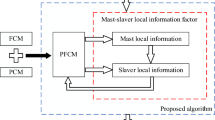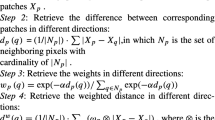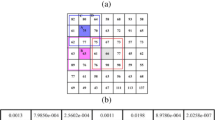Abstract
Local neighborhood information plays an important role in robust fuzzy clustering-related segmentation algorithms, and how to construct local information items is the key to robust fuzzy clustering. Based on existing local information constraints, this paper proposes a model to describe the hierarchy relationship of local neighborhood windows in the master–slave neighborhood model, which combines spatial distance with gray information to suppress the influence of noise on current pixel clustering, and can also well control the balance of noise suppression and detail preservation. Based on this model, this paper proposes a robust fuzzy clustering segmentation algorithm with master-slave neighborhood information constraints. When constraining the neighborhood pixels of a pixel (that is the master neighborhood pixels), the algorithm will further constrain the pixels in the neighborhood window around the master neighborhood pixel (that is the salve neighborhood pixels), thus enhancing the robustness of the algorithm. Experiments results show that the proposed algorithm has good segmentation performance and strong anti-noise performance, even significantly outperforms existing state-of-the-art robust fuzzy clustering-related algorithms in the presence of high noise.






























Similar content being viewed by others
Explore related subjects
Discover the latest articles, news and stories from top researchers in related subjects.References
Muñoz, X., Freixenet, J., Cufı́, X., Martı́, J.: Strategies for image segmentation combining region and boundary information. Pattern Recognit. Lett. 24(1–3), 375–392 (2003). https://doi.org/10.1016/S0167-8655(02)00262-3
Nida, M.Z., Musbah, J.A.: Survey on image segmentation techniques. Procedia Comput. Sci. 62, 797–806 (2015). https://doi.org/10.1016/j.procs.2015.09.027
Shi, J., Malik, J.: Normalized cuts and image segmentation. IEEE Trans. Pattern Anal. Mach. Intell. 22(8), 888–905 (2000). https://doi.org/10.1109/34.868688
Goyal, S., Kumar, S., Zaveri, M.A., Shukla, A.K.: Fuzzy similarity measure based spectral clustering framework for noisy image segmentation. Int. J. Uncertain. Fuzziness Knowl. Based Syst. 25(4), 649–673 (2017). https://doi.org/10.1142/S0218488517500283
Gao, X., Zhang, Y., Wang, H., et al.: A modified fuzzy clustering algorithm based on dynamic relatedness model for image segmentation. Vis. Comput. (2022). https://doi.org/10.1007/s00371-022-02430-4
Miloudi, S., Wang, Y., Ding, W.: An improved similarity-based clustering algorithm for multi-database mining. Entropy 23(5), 553 (2021). https://doi.org/10.3390/E23050553
Fahad, A., Alshatri, N., Tari, Z., Alamri, A., Khalil, I.: A survey of clustering algorithms for big data: taxonomy and empirical analysis. IEEE Trans. Emerg. Top. Comput. 2(3), 267–279 (2014). https://doi.org/10.1109/TETC.2014.2330519
Zhan, K., Nie, F., Wang, J., Yang, Y.: Multiview consensus graph clustering. IEEE Trans. Image Process. 28(3), 1261–1270 (2019). https://doi.org/10.1109/TIP.2018.2877335
Frey, B.J., Dueck, D.: Clustering by passing messages between data points. Science 315(5814), 972–976 (2007). https://doi.org/10.1126/science.1136800
Celik, T., Lee, H.K.: Comments on “A robust fuzzy local information c-means clustering algorithm.” IEEE Trans. Image Process. 22(3), 1258–1261 (2013). https://doi.org/10.1109/TIP.2012.2226048
Nebehay, G., Pflugfelder, R.: Clustering of static-adaptive correspondences for deformable object tracking. In: IEEE Conference on Computer Vision and Pattern Recognition (CVPR). pp. 2784–2791 (2015). https://doi.org/10.1109/CVPR.2015.7298895
Schultz, T., Kindlmann, G.L.: Open-box spectral clustering: applications to medical image analysis. IEEE Trans. Vis. Comput. Graph. 19(12), 2100–2108 (2013). https://doi.org/10.1109/TVCG.2013.181
Noor, S.H., Adnan, M.A., Diyar, Q.Z., Dathar, A.H.: Medical images breast cancer segmentation based on K-means clustering algorithm: a review. Asian J. Res. Comput. Sci. 9(1), 23–38 (2021). https://doi.org/10.9734/AJRCOS/2021/v9i130212
Li, J., Ning, Y., Yuan, Z.M., Yang, C.J.: Research on medical image segmentation based on fuzzy clustering algorithm. Matrix Sci. Pharma. 3(1), 9–11 (2019). https://doi.org/10.4103/MTSP.MTSP_3_19
Anjali, M., Anil, K., Peng, J.: Exploring fuzzy local spatial information algorithms for remote sensing image classification. Remote Sens. 13, 4163 (2021). https://doi.org/10.3390/rs13204163
Jian, J., Wang, K.-L.: A robust nonlocal fuzzy clustering algorithm with between-cluster separation measure for SAR image segmentation. IEEE J. Sel. Top. Appl. Earth Observ. Remote Sens. 7(12), 4929–4936 (2014). https://doi.org/10.1109/JSTARS.2014.2308531
Pei, Y., Cai, X., Li, J., Song, K., Liu, R.: Method for identifying the traffic congestion situation of the main road in cold-climate cities based on the clustering analysis algorithm. Sustainability (2021). https://doi.org/10.3390/SU13179741
Han, J., Xu, J., Nie, F., Li, X.: Multi-view k-means clustering with adaptive sparse memberships and weight allocation. IEEE Trans. Knowl. Data Eng. (2015). https://doi.org/10.1109/TKDE.2020.2986201
Liu, X., Zhu, X., Li, M., Zhu, L.E., Liu, T.: Multiple kernel k-means with Incomplete kernels. IEEE Trans. Pattern Anal. Mach. Intell. 42(5), 1191–1204 (2020). https://doi.org/10.1109/TPAMI.2019.2892416
Goyal, S., Kumar, S., Zaveri, M.A., Shukla, A.K.: Fuzzy similarity measure based spectral clustering framework for noisy image segmentation. Int. J. Uncertain. Fuzziness Knowl.-Based Syst. 25(4), 649–673 (2017). https://doi.org/10.1142/S0218488517500283
Sharma, P.K., Holness, G., Markushin, Y., Melikechi, N.: A family of Chisini mean based Jensen-Shannon divergence kernels. In: IEEE 14th International Conference on Machine Learning and Applications. pp. 109–115 (2015). https://doi.org/10.1109/ICMLA.2015.86
Bei, H., Mao, Y., Wang, W., Zhang, X.: Fuzzy clustering method based on improved weighted distance. Math. Probl. Eng. (2021). https://doi.org/10.1155/2021/6687202
Wang, C., Pedrycz, W., Li, Z.W., Zhou, M.C.: Residual-driven fuzzy c-means clustering for image segmentation. IEEE CAA J. Autom. Sin. 8(4), 876–889 (2021). https://doi.org/10.1109/JAS.2020.1003420
Wang, W., Wang, C., Cui, X., Wang, A.: Improving fuzzy c-means clustering based on adaptive weighting. In: 2008 Fifth International Conference on Fuzzy Systems and Knowledge Discovery. pp. 62–66 (2008). https://doi.org/10.1109/FSKD.2008.160
Bezdek, J.C.: Numerical taxonomy with fuzzy sets. J. Math. Biol. (1974). https://doi.org/10.1007/BF02339490
Bezdek, J.C., Ehrlich, R., Full, W.: FCM: the fuzzy c-means clustering algorithm. Comput. Geosci. 10(2–3), 191–203 (1984). https://doi.org/10.1016/0098-3004(84)90020-7
Bezdek, J.C., Hathaway, R.J., Sabin, M.J., Tucker, W.T.: Convergence theory for fuzzy c-means: counterexamples and repairs. IEEE Trans. Syst. Man Cybern. 17(5), 873–877 (1987). https://doi.org/10.1109/TSMC.1987.6499296
Ahmed, M.N., Yamany, S.M., Mohamed, N., Farag, A., Moriarty, T.: A modified fuzzy c-means algorithm for bias field estimation and segmentation of MRI data. IEEE Trans. Med. Imag. 21(3), 193–199 (2002). https://doi.org/10.1109/42.996338
Chen, S., Zhang, D.: Robust image segmentation using FCM with spatial constraints based on new kernel-induced distance measure. IEEE Trans. Syst. Man Cybern. Part B Cybern. 34(4), 1907–1916 (2004). https://doi.org/10.1109/TSMCB.2004.831165
Szilagyi, L., Benyo, Z., Szilagyi, S.M., Adam, H.S.: MR brain image segmentation using an enhanced fuzzy C-means algorithm. In: Proceedings of the 25th Annual International Conference of the IEEE Engineering in Medicine and Biology Society. pp. 724–726 (2003). https://doi.org/10.1109/IEMBS.2003.1279866
Cai, W., Chen, S., Zhang, D.: Fast and robust fuzzy c-means clustering algorithms incorporating local information for image segmentation. Pattern Recognit. 40(3), 825–838 (2007). https://doi.org/10.1016/j.patcog.2006.07.011
Krinidis, S., Chatzis, V.: A robust fuzzy local information c-means clustering algorithm. IEEE Trans. Image Process. 19(5), 1328–1337 (2010). https://doi.org/10.1109/TIP.2010.2040763
Li, N., Huo, H., Zhao, Y., Chen, X., Tao, F.: A spatial clustering method with edge weighting for image segmentation. IEEE Geosci. Remote Sens. Lett. 10(5), 1124–1128 (2013). https://doi.org/10.1109/LGRS.2012.2231662
Zhang, H., Wang, Q., Shi, W., Mao, H.: A novel adaptive fuzzy local information c-means clustering algorithm for remotely sensed imagery classification. IEEE Trans. Geosci. Remote Sens. 55(9), 5057–5068 (2017). https://doi.org/10.1109/TGRS.2017.2702061
Gong, M., Zhou, Z., Ma, J.: Change detection in synthetic aperture radar images based on image fusion and fuzzy clustering. IEEE Trans. Image Process. 21(4), 2141–2151 (2012). https://doi.org/10.1109/TIP.2011.2170702
Chen, L., Chen Philip, C.L., Lu, M.: A multiple-kernel fuzzy C-means algorithm for image segmentation. IEEE Trans. Syst. Man Cybern. Part B-Cybern. 41(5), 1263–1274 (2011). https://doi.org/10.1109/TSMCB.2011.2124455
Xiang, D., Tang, T., Hu, C., Li, Y., Su, Y.: A kernel clustering algorithm with fuzzy factor: application to SAR image segmentation. IEEE Geosci. Remote Sens. Lett. 11(7), 1290–1294 (2014). https://doi.org/10.1109/LGRS.2013.2292820
Gong, M., Liang, Y., Shi, J., Ma, W., Ma, J.: Fuzzy c-means clustering with local information and kernel metric for image segmentation. IEEE Trans. Image Process. 22(2), 573–584 (2013). https://doi.org/10.1109/TIP.2012.2219547
Bhagyalakshmi, S., Biju, V.G.: Image segmentation using kernel metric and modified weighted fuzzy factor. Int. J. Eng. Res. Technol. (IJERT) 4(5), 68–71 (2015). https://doi.org/10.17577/IJERTV4IS050183
Hemalatha, K.L., Manvi, S., Suresh, H.N.: Adaptive weighted-covariance regularized kernel fuzzy c means algorithm for medical image segmentation. J. Theor. Appl. Inf. Technol. 95(14), 3365–3375 (2017)
Lu, Z., Qiu, Y., Zhan, T.: Neutrosophic C-means clustering with local information and noise distance-based kernel metric image segmentation. J. Vis. Commun. Image Represent. 58, 269–276 (2019). https://doi.org/10.1016/j.jvcir.2018.11.045
Zhang, X., Guo, Q., Sun, Y., Liu, H., Wang, G., Su, Q., Zhang, C.: Patch-based fuzzy clustering for image segmentation. Soft Comput. 23(3), 3081–3093 (2019). https://doi.org/10.1007/s00500-017-2955-2
Li, M., Xu, L., Gao, S., Xu, N., Yan, B.: Adaptive segmentation of remote sensing images based on global spatial information. Sensors (2019). https://doi.org/10.3390/s19102385
Zhang, X., Sun, Y., Liu, H., Hou, Z., Zhao, F., Zhang, C.: Improved clustering algorithms for image segmentation based on non-local information and back projection. Inf. Sci. 550, 129–144 (2020). https://doi.org/10.1016/j.ins.2020.10.039
Tang, Y., Ren, F., Pedrycz, W.: Fuzzy c-means clustering through SSIM and patch for image segmentation. Appl. Soft. Comput. (2020). https://doi.org/10.1016/j.asoc.2019.105928
Jia, X., Lei, T., Du, X., Liu, S., Meng, H., Nandi, A.K.: Robust self-sparse fuzzy clustering for image segmentation. IEEE Access 8, 146182–146195 (2020). https://doi.org/10.1109/ACCESS.2020.3015270
Guo, Y., Sengur, A.: A novel color image segmentation approach based on neutrosophic set and modified fuzzy c-means. Circuits Syst. Signal Process. 32(4), 1699–1723 (2013). https://doi.org/10.1007/s00034-012-9531-x
Lei, T., Jia, X., Zhang, Y., He, L., Meng, H., Nandi, A.K.: Significantly fast and robust fuzzy c-means clustering algorithm based on morphological reconstruction and membership filtering. IEEE Trans. Fuzzy Syst. 26(5), 3027–3041 (2018). https://doi.org/10.1109/TFUZZ.2018.2796074
He, H., Xing, H., Hu, D., Yu, X.: Novel fuzzy uncertainty modeling for land cover classification based on clustering analysis. Sci. China Earth Sci. 62, 438–450 (2018). https://doi.org/10.1007/s11430-017-9224-6
Congalton, R.G.: A review of assessing the accuracy of classifications of remotely sensed data. Remote Sens. Environ. 37, 35–46 (1991). https://doi.org/10.1016/0034-4257(91)90048-B
Fan, J., Zhen, W., Xie, W.: Suppressed fuzzy c-means clustering algorithm. Pattern Recognit. Lett. 24, 1607–1612 (2003). https://doi.org/10.1016/S0167-8655(02)00401-4
Zhao, F., Fan, J., Liu, H.: Optimal-selection-based suppressed fuzzy c-means clustering algorithm with self-tuning non local spatial information for image segmentation. Expert Syst. Appl. 41(9), 4083–4093 (2014). https://doi.org/10.1016/j.eswa.2014.01.003
Wu, C., Liu, N.: Suppressed robust picture fuzzy clustering for image segmentation. Soft Comput. 25, 3751–3774 (2021). https://doi.org/10.1007/s00500-020-05403-8
Liu, B., He, S., He, D., Zhang, Y., Guizani, M.: A spark-based parallel fuzzy c-means segmentation algorithm for agricultural image big data. IEEE Access 7, 42169–42180 (2019). https://doi.org/10.1109/ACCESS.2019.2907573
Jha, P., Tiwari, A., Bharill, N., Ratnaparkhe, M., Mounika, M., Nagendra, N.: Apache Spark based kernelized fuzzy clustering framework for single nucleotide polymorphism sequence analysis. Comput. Biol. Chem. 92, 107475 (2021). https://doi.org/10.1016/j.compbiolchem.2021.107454
https://www2.eecs.berkeley.edu/Research/Projects/CS/vision/bsds
Wang, Q., Wang, X., Fang, C., Yang, W.: Robust fuzzy C-means clustering algorithm with adaptive spatial & intensity constraint and membership linking for noise image segmentation. Appl. Soft. Comput. (2020). https://doi.org/10.1016/j.asoc.2020.106318
Gao, Y., Wang, Z., Xie, J., Pan, J.: A new robust fuzzy c-means clustering method based on adaptive elastic distance. Knowl.-Based Syst. (2022). https://doi.org/10.1016/j.knosys.2021.107769
Wang, Q., Wang, X., Fang, C., Jiao, J.: Fuzzy image clustering incorporating local and region-level information with median memberships. Appl. Soft. Comput. (2021). https://doi.org/10.1016/j.asoc.2021.107245
Zhou, Y., Kwonga, S., Guo, H., Gao, W., Wang, X.: Bilevel optimization of block compressive sensing with perceptually nonlocal similarity. Inf. Sci. 360, 1–20 (2016). https://doi.org/10.1016/j.ins.2016.03.027
Zhou, Y., Guo, H.: Collaborative block compressed sensing reconstruction with dual-domain sparse representation. Inf. Sci. 77, 93 (2019). https://doi.org/10.1016/j.ins.2018.08.064
Acknowledgements
This work was supported by the National Natural Science Foundation of China (Grant Numbers 61671377), and the Natural Science Foundation of Shaanxi Province (2022JM-370). Wu and Wu would like to thank the anonymous reviewers for their constructive suggestions to improve the overall quality of the paper. Besides, Wu and Wu would like to thank the School of Electronic Engineering, Xi’an University of Posts & Telecommunications, Xi’an, China for financial support.
Author information
Authors and Affiliations
Corresponding author
Ethics declarations
Conflict of interest
The authors declare that they have no known competing financial interests or personal relationships that could have appeared to influence the work reported in this paper.
Additional information
Publisher's Note
Springer Nature remains neutral with regard to jurisdictional claims in published maps and institutional affiliations.
Rights and permissions
Springer Nature or its licensor (e.g. a society or other partner) holds exclusive rights to this article under a publishing agreement with the author(s) or other rightsholder(s); author self-archiving of the accepted manuscript version of this article is solely governed by the terms of such publishing agreement and applicable law.
About this article
Cite this article
Wu, C., Wu, W. Master-slave hierarchy local information driven fuzzy C-means clustering for noisy image segmentation. Vis Comput 40, 865–897 (2024). https://doi.org/10.1007/s00371-023-02821-1
Accepted:
Published:
Issue Date:
DOI: https://doi.org/10.1007/s00371-023-02821-1




